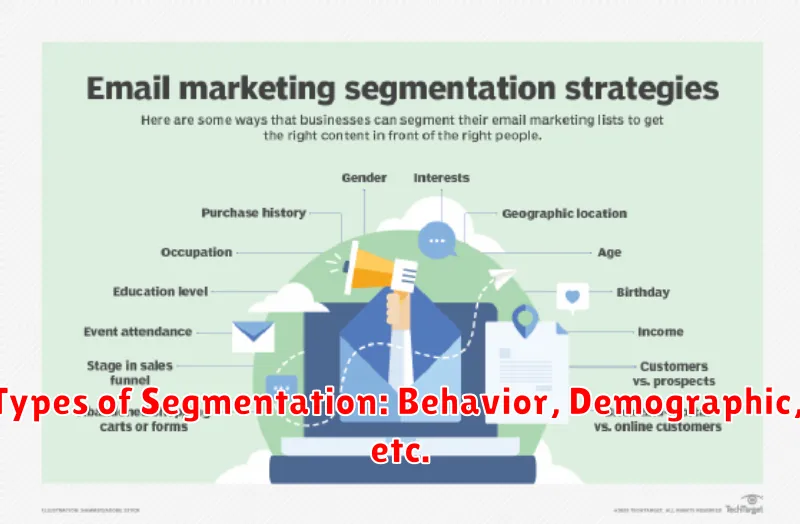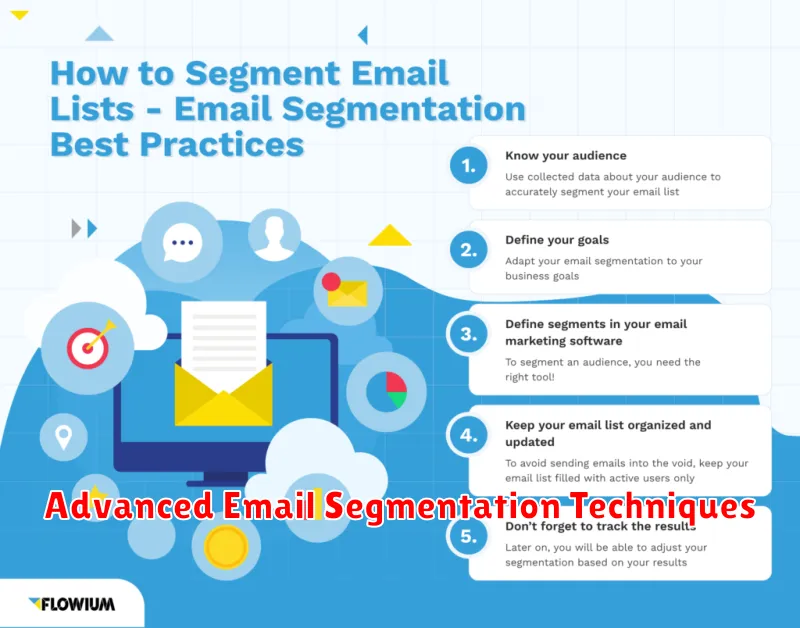In today’s competitive digital landscape, email marketing remains a crucial tool for reaching and engaging your target audience. However, simply sending out mass emails is no longer sufficient. To truly maximize your email marketing ROI, you need to leverage the power of advanced email segmentation techniques. This allows you to deliver highly personalized messages that resonate with individual subscribers, leading to increased open rates, click-through rates, and ultimately, conversions. This article will delve into cutting-edge email segmentation strategies that go beyond basic demographics, enabling you to create hyper-targeted campaigns that deliver exceptional results.
Moving past rudimentary segmentation based solely on location or age, this article explores advanced email segmentation techniques that leverage behavioral data, purchase history, website activity, and other key indicators. We’ll examine how to identify and segment your most valuable subscribers and tailor your messaging accordingly. By implementing these advanced segmentation strategies, you can cultivate stronger customer relationships, boost engagement, and drive significant revenue growth. Prepare to unlock the full potential of your email marketing efforts with these powerful and actionable insights.
Why Segmentation Boosts Engagement
Segmentation allows you to send highly targeted emails that resonate with specific subscriber groups. By tailoring content to individual preferences and needs, you increase the likelihood of recipients opening, reading, and acting upon your messages.
Generic email blasts often end up ignored or marked as spam. Segmented campaigns, however, deliver relevant information, fostering a stronger connection with your audience and leading to improved open rates, click-through rates, and conversions.
Types of Segmentation: Behavior, Demographic, etc.

Segmentation divides your audience into smaller groups based on shared characteristics. This allows for more targeted and effective email campaigns.
Common segmentation types include:
- Behavioral: Segmenting based on website activity, purchase history, or email engagement (opens, clicks).
- Demographic: Using characteristics like age, gender, location, or income to group subscribers.
- Psychographic: Segmenting based on lifestyle, values, interests, and personality traits.
- Geographic: Grouping subscribers by their physical location (country, state, city).
Tools That Help You Segment Lists
Several tools can streamline the process of segmenting your email lists. Choosing the right tool depends on your needs and existing marketing stack. Email marketing platforms often have built-in segmentation features, allowing you to divide your audience based on demographics, behavior, and engagement. CRM systems can integrate with your email platform, providing a deeper understanding of customer interactions and enabling more refined segmentation.
Dedicated segmentation tools offer advanced features like predictive analytics and AI-powered insights to help you identify hidden segments and personalize messaging. Finally, marketing automation platforms can automate the entire process, from segment creation to campaign delivery, based on pre-defined triggers and workflows.
Creating Personalized Email Campaigns
Personalized email campaigns leverage segmentation data to deliver highly relevant content to individual subscribers. This targeted approach fosters stronger engagement and drives better results.
By dynamically inserting subscriber-specific information, such as name or purchase history, emails feel more personal and less generic. This personalization creates a sense of individual attention, boosting open and click-through rates. Additionally, personalized offers based on individual preferences and behaviors significantly increase conversions.
Dynamic Content Blocks Explained
Dynamic content blocks represent a powerful email segmentation technique. They allow you to customize sections of your email based on recipient data. This means different subscribers receive different versions of the same email, making the content more relevant and engaging.
By leveraging information like demographics, past purchases, or browsing behavior, dynamic content blocks help create a more personalized experience. This can lead to increased open rates, click-through rates, and ultimately, conversions.
Automation Based on Segment Behavior
Segment behavior drives effective automated email campaigns. By analyzing how different segments interact with your emails (opens, clicks, purchases), you can tailor automated responses.
For example, a welcome series can be customized based on a user’s initial signup source. Users from a free trial might receive different onboarding emails compared to those from a paid advertisement.
Similarly, purchase behavior can trigger automated upselling or cross-selling emails, leading to increased customer lifetime value.
A/B Testing Segmented Campaigns
After segmenting your audience, A/B testing becomes even more crucial. Test different variations of your emails on smaller, segmented groups. This allows you to tailor messaging and offers for optimal performance within each segment.
Consider testing elements like subject lines, email copy, call-to-action buttons, and sending times. By analyzing the results, you can identify what resonates best with each segment and refine your campaigns for higher engagement and conversion rates.
Monitoring Metrics Like CTR and Opens
Monitoring key metrics is crucial for evaluating segmentation effectiveness. Track metrics like open rates and click-through rates (CTR) for each segment.
Low open rates might indicate issues with subject lines or delivery times. Poor CTR could signal irrelevant content or ineffective calls to action.
Avoiding Spam Triggers with Segments
Email segmentation plays a crucial role in avoiding spam triggers. By dividing your audience into specific groups, you can tailor your messaging to their interests and behaviors, reducing the likelihood of your emails being marked as spam.
Sending irrelevant content to uninterested recipients increases spam complaints. Segmentation allows you to target specific segments with relevant content, keeping engagement high and spam complaints low. This practice improves your sender reputation and email deliverability.
Consider segmenting by engagement level. Send less frequent emails to low-engagement segments to avoid overwhelming them. Focus on high-engagement segments with more targeted and valuable information.
Real-Life Case Studies on ROI
Examining real-world examples demonstrates the impact of advanced email segmentation. A case study involving a B2B SaaS company revealed a 30% increase in conversion rates after implementing behavioral segmentation. By targeting users based on their in-app activity, they delivered more relevant content, resulting in higher trial sign-ups.
Another case study highlighted an e-commerce retailer who saw a 15% boost in revenue by segmenting customers based on purchase history and browsing behavior. Personalized product recommendations led to increased average order value and customer lifetime value.

